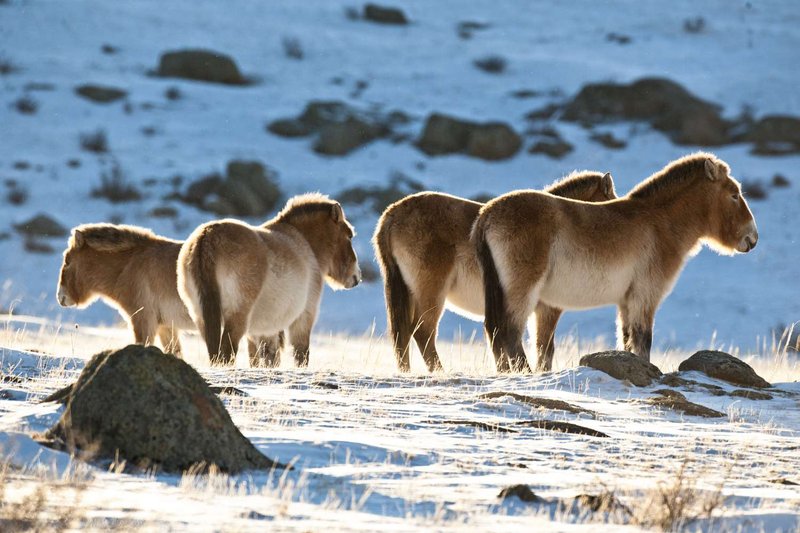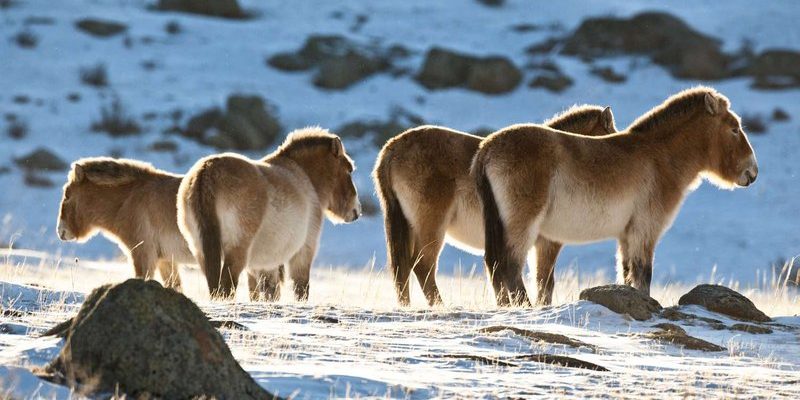
Let’s dive into how these horses manage to not only survive but also thrive where many other species might struggle. From their physical adaptations to their behavior and social structures, we’ll explore the secrets that enable Przewalski’s horses to endure their challenging habitats.
Physical Adaptations: Nature’s Design
Przewalski’s horses are built for survival. They have a sturdy, compact frame with a thick neck and short legs, which helps them navigate rocky terrain and extreme weather. Their bodies possess a layer of thick fur that insulates them against bitter cold. Here’s a quick breakdown of their physical features:
- Thick Fur: In harsh winters, their dense coat traps heat, keeping them warm.
- Shorter Legs: Unlike other horse breeds, their shorter legs provide agility to maneuver through tough landscapes.
- Strong Hooves: Their hooves are tough and well-suited for walking on uneven ground, preventing injury.
These specialized features are not just random traits; they are evolutionary tools that help Przewalski’s horses face the bitter cold and rocky terrain of their natural habitats. You might be wondering how these adaptations came about. Simply put, over generations, those that adapted best to their environment were the ones that survived and thrived, passing on their genes to the next generation.
Finding Food: Grazing in Tough Conditions
Surviving in the wild often comes down to finding enough food. Przewalski’s horses primarily eat grasses, which can be sparse in their habitat. Their digestive system is adapted to extract maximum nutrients from low-quality forage. Here’s how they do it:
- Selective Grazing: These horses are clever foragers. They can identify the most nutritious grasses, even when the selection is limited.
- Efficient Digestion: Their stomachs can break down tough plant materials, allowing them to thrive even when food is scarce.
- Water Conservation: They can go long periods without drinking water, obtaining moisture from the grass they consume.
Imagine not having a reliable meal every day. Przewalski’s horses have honed skills to make the best out of their environment, ensuring they stay nourished during the dry seasons. Their ability to adapt their diet is a remarkable testament to their survival instincts.
Social Structure: Herd Dynamics
When you think about animals in the wild, you might picture them living in solitude. However, Przewalski’s horses are social creatures. They live in small herds, usually led by a dominant stallion. This social structure offers several benefits for survival:
- Protection in Numbers: Herds provide safety. When predators threaten, the group can work together to defend against attacks.
- Shared Knowledge: Older horses teach younger ones where to find food and water, passing down survival skills.
- Social Bonds: Strong relationships within the herd help reduce stress and improve overall well-being, which is essential in harsh environments.
Think of their herd dynamics as a close-knit family that helps each other in tough times. This structure not only protects individual members but also enhances the group’s chances of survival in an unforgiving landscape.
Behavioral Adaptations: Smart Survival Strategies
Beyond their physical traits and social structures, Przewalski’s horses exhibit certain behaviors that further enhance their survival. Here are some key strategies:
- Foraging Patterns: They often graze at dawn and dusk when temperatures are cooler, conserving energy.
- Understanding Terrain: These horses have a keen sense of their surroundings, choosing grazing areas that offer the best protection and resources.
- Vocal Communication: They use sounds to alert each other to potential dangers, ensuring the herd stays safe.
Think of these behaviors as a well-practiced routine. By following these patterns, Przewalski’s horses can maximize their chances of finding food while staying safe from predators. It’s a beautiful example of how instinct and learned behaviors contribute to survival.
Environmental Challenges: Adapting to Change
Despite their impressive adaptations, Przewalski’s horses face ongoing challenges. Climate change and habitat loss threaten their survival. They are now considered a critically endangered species. This situation brings up the question: how do they cope with these increasing pressures?
- Seeking New Habitats: When their traditional ranges become inhospitable, these horses may move in search of more suitable environments.
- Conservation Efforts: Numerous organizations are working to protect their habitats, ensuring these magnificent creatures can continue to roam freely.
- Monitoring Populations: Researchers track herds to learn more about their behaviors and needs, helping to inform conservation strategies.
It’s a bit like trying to survive in a changing neighborhood. Przewalski’s horses must adapt quickly to new realities while relying on conservation efforts to help maintain their existence. It’s a collective effort that involves both the animals and humans.
Lessons in Resilience: What We Can Learn
The story of Przewalski’s horses is not just about survival; it’s also a lesson in resilience. Their ability to adapt to harsh environments inspires us to think about our own challenges. Here’s what we can take away:
- Adaptability is Key: Just like these horses, we can adjust our strategies when facing difficulties, whether personal or professional.
- Community Matters: Support from others can make a difference in overcoming obstacles, much like how horses rely on their herds.
- Respect for Nature: Understanding and protecting wildlife can help preserve unique species and their ecosystems for future generations.
Honestly, observing how Przewalski’s horses navigate their world can remind us of our strength and resilience. We can find inspiration in their story, encouraging us to face challenges with courage.
In conclusion, Przewalski’s horses are truly remarkable creatures that have survived through millennia in some of the world’s harshest environments. Their unique adaptations, social structures, and clever behaviors provide valuable insights into survival in challenging conditions. As we learn more about these incredible animals, we can continue to support efforts that protect them, ensuring that future generations can appreciate their beauty and resilience.

